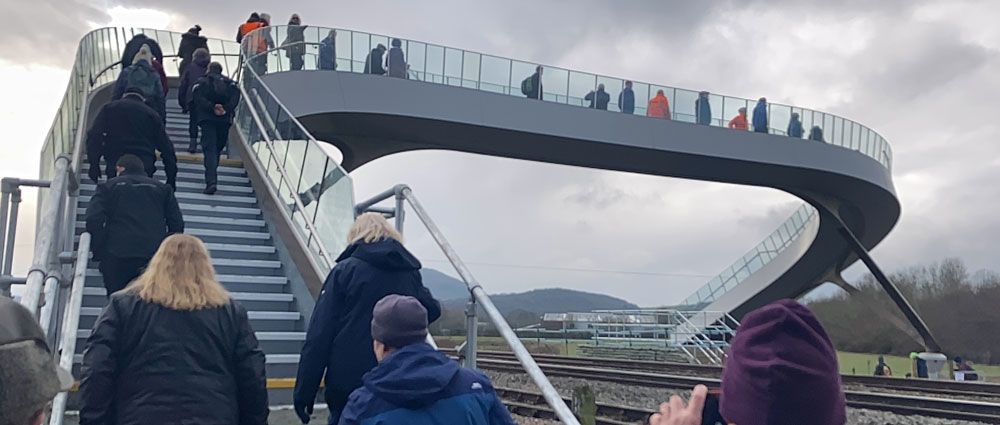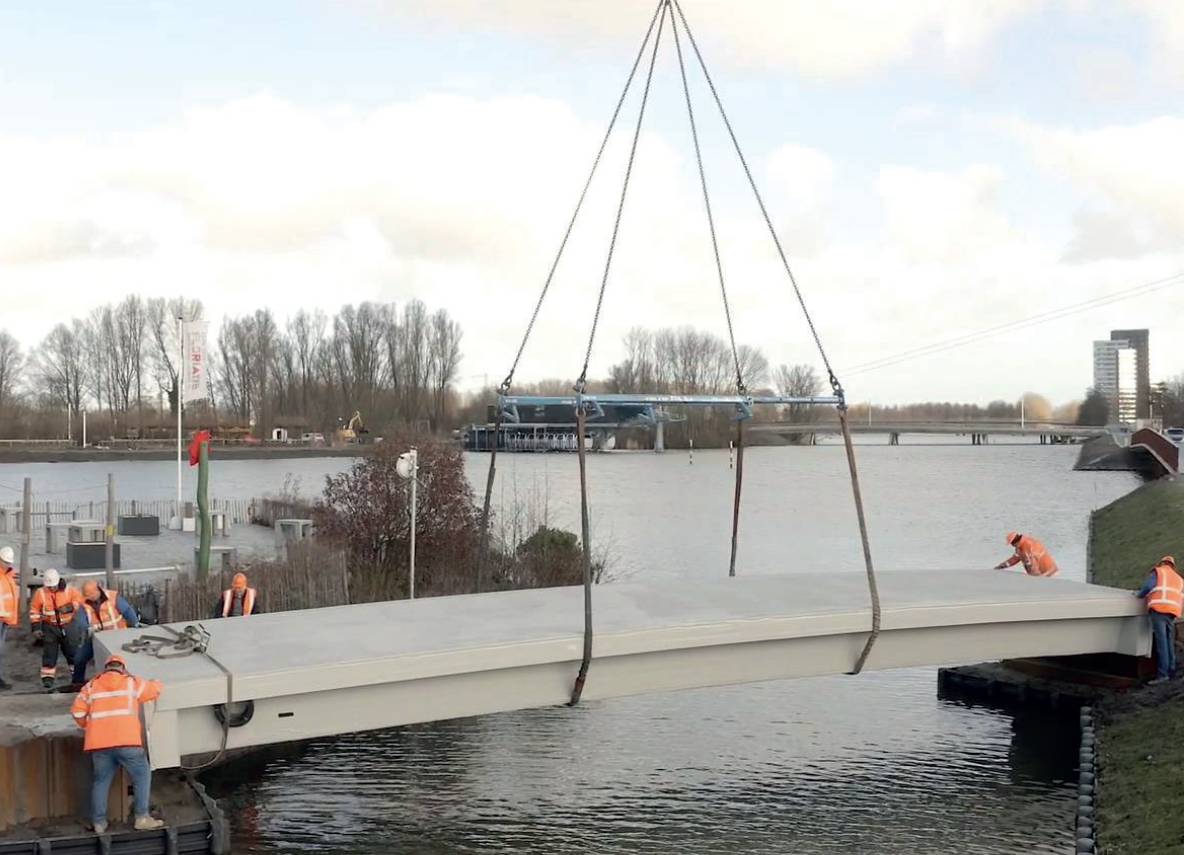Future of Bridges | Overview
New found strength
As the construction sector strives to cut carbon emissions and reduce project costs, it has been increasingly looking to alternative materials for bridge construction. Thomas Johnson reports.
For decades, the construction industry has relied on concrete and steel for bridge construction. The extensive experience of using these materials and the in-depth knowledge of their behaviour has made industry players reluctant to use alternatives.
But some clients and contractors are willing to take the risk to prove that using non-traditional materials has benefits.
 Glass, carbon and flax fibres were used for Network Rail’s Flow Bridge in the Shropshire Hills
Glass, carbon and flax fibres were used for Network Rail’s Flow Bridge in the Shropshire Hills
In January, a 21m long footbridge which incorporates fibre-reinforced polymer (FRP) opened just north of Craven Arms in the Shropshire Hills.
The Fibre-reinforced polymer, Lower cost, Optimised design, Working footbridge, known as Flow, is part of a Network Rail effort to replace dangerous rural level crossings with low carbon, low-cost footbridges.
FRP consists of strong fibres embedded in epoxy resin. The fibres are used to provide strength and stiffness and in the case of the Flow bridge they are glass, flax and carbon.
Glass fibres were used in the bridge’s spine and deck, flax fibres were incorporated in the spine and carbon fibre was added to the heels of the spine together with steel. Other materials used include aluminium plates and toughened laminated glass for the parapets and stainless steel bolts for the connections.
Network Rail says the Flow Bridge has several advantages over an equivalent steel structure.
“One of the main advantages of constructing with a flax fibre bio-composite is its weight Among these advantages, it weighs half of its steel equivalent, making it cheaper to transport and install.
It also costs 40% less and has a lower carbon footprint.Network Rail principal design engineer for the Flow project Ahmad Kamara explains that for the Mark 2 version of the bridge, Network Rail is researching the use of other alternative materials for some parts of the structure.
“For the Mark 2 Flow Bridge, we have one version for the longer spans where we are going with carbon and flax as the main materials for the spine. Then, in the shorter spans, where we want something stronger than glass but not as strong as carbon and also less expensive, we’re looking at basalt as an alternative material.”
“The main setback for the carbon footprint is in basalt’s manufacture but once it’s been manufactured, it has got fantastic sustainability properties and it can be recycled at end of life as well,” he explains.
The manufacture of basalt fibres is energy intensive as volcanic basalt rock has to be melted at 1,400°C. But suppliers claim that basalt fibre reinforced polymer is less carbon intensive to produce than steel and has other comparative advantages including its lighter weight and higher tensile strength (NCE, May).
Even though the carbon footprint for the Mark 2 bridge has yet to be fully calculated, Network Rail’s current projection is that it will be at least 40% smaller than that of an equivalent steel bridge.
KEY FACT
21mLength of Network Rail’s Flow footbridge
BIOMATERIALS
Elsewhere in the industry, other materials are also being explored as low carbon alternatives.
The use of biomaterials derived from living organisms including plants, animals and fungi, is an area the construction sector is increasingly exploring as it seeks to reduce its carbon footprint.
With the European Union’s BioEconomy Strategy stressing the need for a shift to natural materials, the Smart Circular Bridge Project is exploring their use in three pedestrian and cycle bridges.
The €6.86M (£5.96M) project is led by the Eindhoven University of Technology in the Netherlands. A total of 15 partners are collaborating on it, including universities, contractors and suppliers.
The European Union provided £3.41M, with the rest of the budget covered by the project partners.
The team has been researching the use of flax fibres to increase the bio-content of composites in bridges. Flax skin is woven into thin strands to make fibres, which are then set in resin that acts as a glue to bind them together.
The benefit of using flax is that it grows much faster than other biomaterials.
“The disadvantage for us is that the resin producers aren’t that far along to have something that’s fully realised
“We need to be more circular and we use a lot of wood products. A tree needs to grow for at least for a couple of years [before it can provide sufficient material], whereas flax can be harvested every year,” says Smart Circular Bridge Project project manager Stephanie Lamerichs.
“This means you use less agricultural land to produce a bridge and a new bridge can be grown in a couple of years on that same field.”
The project has gone a step further by committing to use a bio-resin with the flax to make a bio-composite which can be used on the three bridges that will be constructed.
The first “Smart Circular Bridge” opened to the public in Almere, the Netherlands in April last year. Its span is 15m and was constructed using 3.2t of flax fibres. The bridge deck and parapet incorporate flax fibres, while steel was used for the abutments and beams.
“One of the main advantages of constructing with a flax fibre biocomposite is its weight. The bridge that we produced in Almere is only 6t and it was made in one piece, transported in one piece and placed in one piece with one crane.
“The lower weight is a real advantage because it also reduced the dimensions of the abutments and the foundation of the bridge,” Lamerichs explains.
The resin used by the Smart Circular Bridge Project is still not completely made from biomaterials due to supply constraints.
“The disadvantage for us is that the resin producers aren’t that far along to have something that’s fully realised. It’s also really expensive to change the combination of resin with the flax fibres because you have to do all the tests and the producers mainly do not want to,” says Lamerichs.
The low data availability for the use of biomaterials and the industry’s deep understanding of steel and concrete are obstacles to their wider adoption in bridge construction.
Kamara says: “The main obstacle preventing the use of biomaterials as primary structural elements is they are relatively new materials with lack of data on their long term mechanical behaviour and deterioration. This makes us [Network Rail] a bit sceptical to put it as a principal material for a structure with a 120 year design life.”
MONITORING
The lack of data that will give designers and engineers assurance that these alternative materials will act as they expect makes the monitoring of structures incorporating them an important endeavour.
“If we have a structure which is monitored and we can see its real-life performance, we have real life assurance,” says Network Rail Wales and Borders programme manager Andy Cross.
 The 6t Smart Circular Bridge in Almere, the Netherlands, is made of flax fibre bio-composite
The 6t Smart Circular Bridge in Almere, the Netherlands, is made of flax fibre bio-composite
“If we are starting to see a drop-off and degradation of those materials, we can see it. If they are performing very well, then we can extend their design lives.”
Network Rail is monitoring the Flow Bridge to assess the performance of elements for which alternative materials have been used. The parameters measured are strains, temperature, footfalls, displacement and rotations.
“The spine structure performance and load distribution to the deck units are being monitored. Footfall is also being recorded.
“We are currently working with Bristol University to interpret the raw data. However initial findings show the bridge is performing close to the design modelling,” says Cross.
Back in the Netherlands, the Smart Circular Bridge Project team is monitoring the performance of the Almere bridge as the result could influence the future uptake of biocomposites for this application.
Weight and temperature sensors have been placed on the structure, as well as an accelerometer which measures vibrations.
“What we have learned is that the outside temperature – the heating from the sun – has an effect on the strains in the deck which we didn’t really know before,” Lamerichs says.
She adds that a researcher from the University of Eindhoven is analysing deformations caused by solar heat.
She stresses that monitoring results show that “the bridge performs better than expected and the deflections are smaller than calculated, which means the bridge is stronger and stiffer than expected”.
“The load tests carried out also show that the bridge deformations are linear and once the load is removed, the deck deforms back to its original state,” Lamerichs adds.
NEW BRIDGES
The Smart Circular Bridge Project will be completed after its next two bridges are installed. One will be built in Ulm, Germany and the other in Bergen Op Zoom in the Netherlands.
Lamerichs is sure her team’s work will inform efforts to scale up the design of bio-based bridges so that one-day bridges to carry roads and railways can be built using flax fibres.
“The load tests carried out also show that the bridge deformations are linear and once the load is removed, the deck deforms back to its original stateAfter its Flow Bridge Mark 2 design is finished, Network Rail has big aspirations to develop bridges made from a whole host of bio and biocomposite materials.
“Half of the materials we have now, were not even available on the market when we built the prototype [the Shropshire bridge].
“Now we’ve got better quality materials so the evolution in composites is like a steep graph,” says Kamara.
Cross adds that the Flow project shows that the sector can do things differently, in terms of materials and design and still meet cost and carbon targets for bridge projects.
“With the right people and the right attitude, you can meet these targets as well as do things more efficiently”.